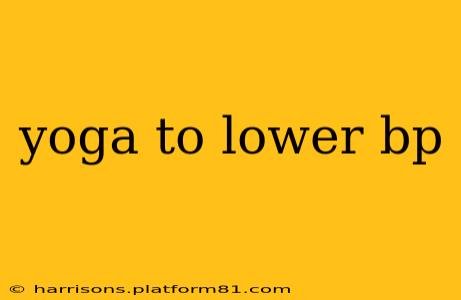High blood pressure, or hypertension, affects millions worldwide, significantly increasing the risk of heart disease, stroke, and kidney failure. While medication is often necessary, lifestyle modifications play a crucial role in managing blood pressure. Yoga, with its emphasis on physical postures, breathing techniques, and meditation, has emerged as a powerful tool in this regard. This comprehensive guide explores how yoga can help lower blood pressure, addressing common questions and concerns.
How Does Yoga Help Lower Blood Pressure?
Yoga's effectiveness in lowering blood pressure stems from its multifaceted approach. The practice combines physical activity, stress reduction, and mindful awareness, all of which contribute to improved cardiovascular health. Specific mechanisms include:
-
Relaxation Response: Yoga's breathing exercises and meditation techniques activate the parasympathetic nervous system, counteracting the effects of stress hormones that elevate blood pressure. This "relaxation response" leads to lower heart rate and reduced vascular resistance.
-
Improved Cardiovascular Fitness: Certain yoga poses, particularly those involving forward bends and inversions, improve circulation and strengthen the heart muscle. Regular practice enhances cardiovascular fitness, contributing to lower blood pressure levels.
-
Reduced Stress and Anxiety: Chronic stress is a major contributor to high blood pressure. Yoga's stress-reducing effects, through mindful movement and meditation, help manage stress levels and, consequently, blood pressure.
-
Weight Management: Yoga can help with weight loss or maintenance, another crucial factor in managing hypertension. By increasing physical activity and promoting mindful eating habits, yoga indirectly contributes to healthier blood pressure levels.
What Types of Yoga Are Best for Lowering Blood Pressure?
While various yoga styles offer benefits, some are particularly well-suited for managing blood pressure:
-
Hatha Yoga: This gentle style emphasizes basic postures (asanas) held for extended periods, promoting relaxation and improved circulation. Its slow pace and focus on breathwork make it ideal for beginners and those with hypertension.
-
Restorative Yoga: This calming style involves passive postures supported by props, minimizing physical exertion while maximizing relaxation. Restorative yoga is excellent for reducing stress and promoting deep relaxation, beneficial for lowering blood pressure.
-
Iyengar Yoga: This precise style emphasizes proper alignment and the use of props to support the body, making it accessible to individuals with various physical limitations. The focus on correct posture improves circulation and promotes relaxation.
It's important to choose a style that suits your fitness level and preferences. Consulting with a qualified yoga instructor experienced in working with individuals with hypertension is recommended.
Is Yoga Safe for People with High Blood Pressure?
Yes, yoga is generally safe for people with high blood pressure, but certain precautions should be observed. Individuals with severe hypertension or other health conditions should consult their doctor before starting a yoga program. Modifying or avoiding certain poses, such as those involving headstands or deep inversions, might be necessary. Furthermore, a gradual introduction to yoga practice is recommended, building up intensity and duration over time.
How Often Should I Practice Yoga to Lower My Blood Pressure?
The frequency of yoga practice needed to see significant blood pressure reduction varies. However, most studies suggest that regular practice, at least three to five times a week, yields the most substantial benefits. Even shorter, 10-15 minute sessions daily can offer significant stress relief and contribute to overall well-being. Consistency is key to experiencing the long-term benefits of yoga for blood pressure management.
Can Yoga Replace Medication for High Blood Pressure?
Yoga should not replace medication prescribed by a doctor for high blood pressure. It's a complementary therapy that can enhance the effectiveness of medication and improve overall health. Always consult your doctor before making any changes to your medication regimen. Yoga can be a valuable tool in managing hypertension, but it should be used in conjunction with medical advice and treatment.
What are the Risks of Doing Yoga for High Blood Pressure?
While generally safe, yoga carries minimal risks for individuals with hypertension. These risks can be minimized by choosing a suitable yoga style, practicing under the guidance of a qualified instructor, and listening to your body. Pushing yourself too hard can lead to injury or increased blood pressure. Starting slowly and gradually increasing the intensity and duration of practice is crucial. If you experience dizziness, lightheadedness, or other discomfort during practice, stop immediately and consult your doctor or yoga instructor.
Conclusion
Yoga offers a holistic and effective approach to managing high blood pressure. By combining physical postures, breathing techniques, and meditation, it promotes relaxation, improves cardiovascular fitness, and reduces stress, all of which contribute to lower blood pressure levels. However, it's crucial to consult with your doctor and choose a suitable yoga style and practice level. When combined with medical advice and other lifestyle modifications, yoga can be a powerful tool in leading a healthier, more balanced life with lower blood pressure.
